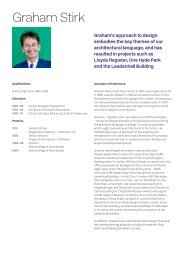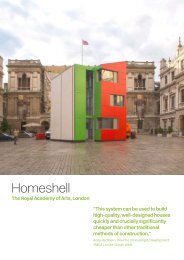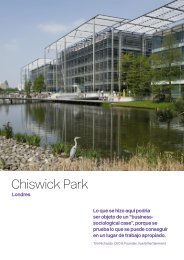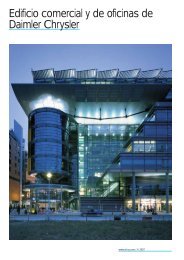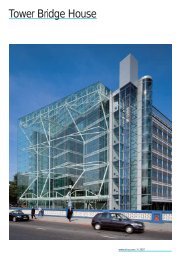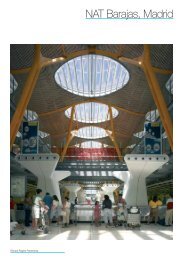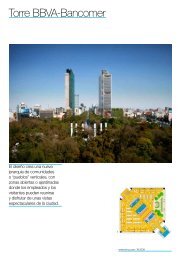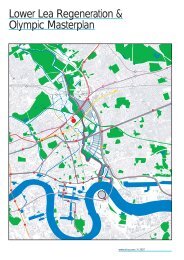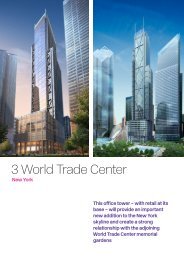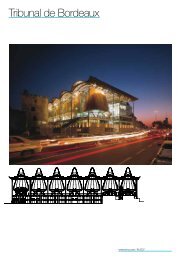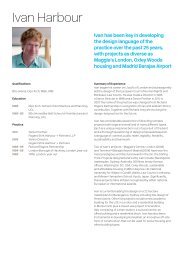Fleetguard Factory
Fleetguard Factory
Fleetguard Factory
You also want an ePaper? Increase the reach of your titles
YUMPU automatically turns print PDFs into web optimized ePapers that Google loves.
<strong>Fleetguard</strong> <strong>Factory</strong><br />
Awards<br />
Concours de Plus Beaux Ouvrages de<br />
Construction Metallique<br />
1982<br />
Constructa Preis for ‘overall excellence<br />
in the field of architecture’<br />
1986<br />
www.rsh-p.com / © 2007
Place/Date<br />
Britanny, France 1979 - 1981<br />
Client<br />
Cummins Engine Company/Ville de Quimper<br />
Area<br />
8,750 m²<br />
Architect<br />
Richard Rogers Partnership<br />
Structural Engineer<br />
Ove Arup & Partners<br />
Quantity Surveyor<br />
Northcroft Neighbour and Nicholson<br />
Project Manager<br />
Flee tguard International Corporation<br />
Located in a newly designated industrial<br />
zone within a few kilometres of the town of<br />
Quimper in Brittany and adjacent to a major<br />
road, the site provides magnificent views<br />
across country towards Quimper and the<br />
south Brittany coast.<br />
<strong>Fleetguard</strong> specialises in manufacturing<br />
heavy duty engine filters and the new plant<br />
at Quimper was to include production lines<br />
for air, fuel and oil filters, storage facilities<br />
and administrative headquarters totalling<br />
8,750 m 2 but with a future growth potential<br />
of up to 40,000 m 2 over 15 years. The highly<br />
adaptable building, capable of responding<br />
to changing needs and functions, has<br />
established the company in mainland<br />
Europe.<br />
The design places great emphasis on<br />
minimising intrusion on the landscape.<br />
Surplus excavated soil has been used to<br />
create a carefully controlled landscaping<br />
scheme, relegating access roads to the<br />
perimeter of the site and segregating<br />
industrial from personnel traffic. A dynamic<br />
suspension structure reduces both roof span<br />
and structural depth, diminishing the overall<br />
mass of the building. The external structure<br />
frees the interior roof zone for flexible<br />
services distribution, unhindered by the<br />
excessive structural depth of a conventional<br />
frame of similar span. The stairwell is<br />
enclosed in glass so that it becomes the<br />
focal point linking both physically and visually<br />
the production and administrative areas.<br />
The main structure consists of elements<br />
which require very little fabrication and can<br />
be joined simply. Structural connections<br />
necessary for extending the building can be<br />
made without removing existing cladding,<br />
thereby avoiding disruption to the use of<br />
the building. Total steel weight is 47kg/m²,<br />
about 17% less than conventional structures<br />
of comparable bay size. The cladding<br />
is clearly articulated from the structural<br />
frame to facilitate bay by bay expansion<br />
without disruption to <strong>Fleetguard</strong>’s activities,<br />
and is separated from the roof zone by<br />
a continuous band of high-level glazing,<br />
bringing natural light into all parts of the<br />
building.<br />
The tension structure, using<br />
15 percent less steel than a<br />
conventional design, gives the<br />
building a legible, spare and<br />
dynamic expression which<br />
grows from the basic and<br />
key principle of least effort for<br />
maximum return.<br />
<strong>Fleetguard</strong> <strong>Factory</strong>



